Hoya Krimson Queen is one of the variegated variants of the Hoya carnosa. It is known for its pretty and unique triple-shaded foliage. It has beautiful green leaves with white and pink variegation along the edges. This plant is one of the varieties of creeper or vine native to the subtropical forests of Southeast Asia. Hoya ‘Krimson Queen’ is one of the fastest-growing varieties of Hoya and one of the most sought-after indoor vines in the world.
Interesting, right? Let’s read more below.
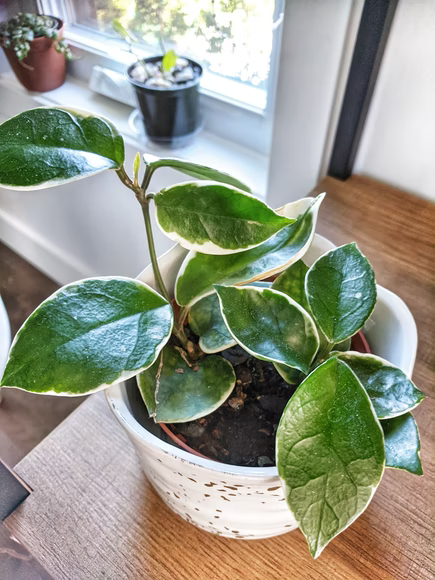
Hoya Krimson Queen Profile
General Information
Hoya Krimson Queen, also known as Hoya Variegata, is a variegated variant of Hoya carnosa. It belongs to the Apocynaceae family and belongs to the genus Hoya. Hoyas are perennial plants and epiphytic vines that grow on rope-like branches. The mature plant length is approximately 59 to 79 inches. The plant produces beautiful star-shaped, waxy pink flowers that are fragrant.
Hoya Krimson queen is endemic to Southeast Asia in the Philippines, Thailand, Malaysia, China, India, Indonesia, and Polynesia.
Etymology
Cobia patented the Hoya Krimson Queen as the “Tricolor” in the 1950s. It was most commonly sold under its brand name “Hoya Krimson Queen”. It belongs to the Apocynaceae family and belongs to the genus Hoya.
The genus name “Hoya” was coined by botanist Robert Brown, honoring his botanist friend, Thomas Hoy.
Flowering
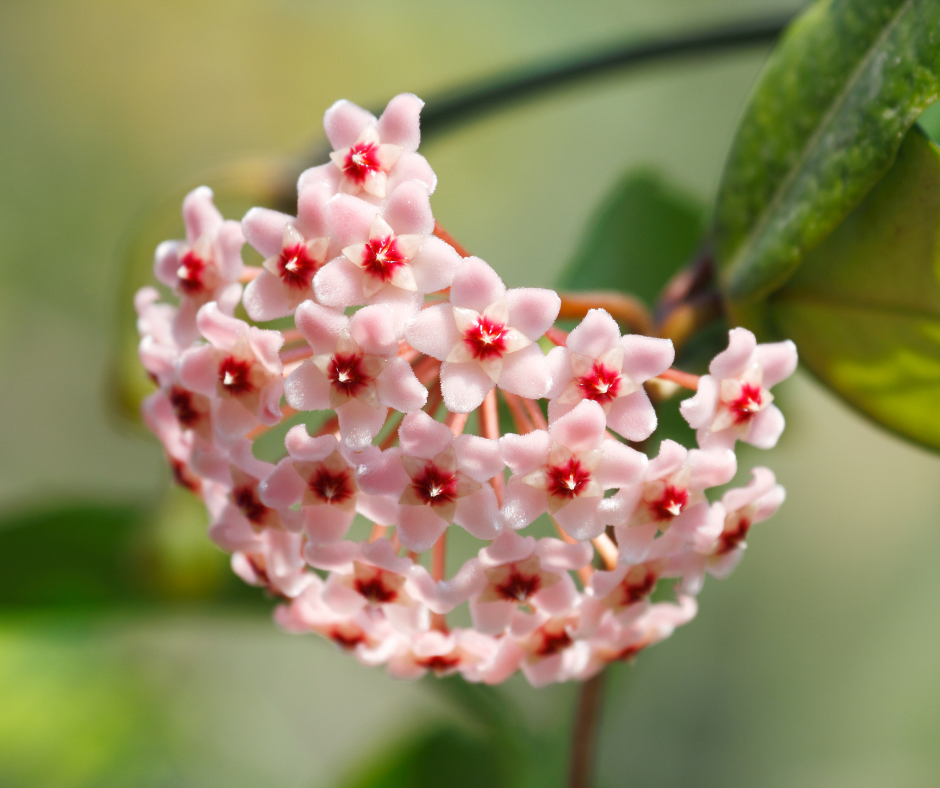
Hoya Krimson Queen flowers are one of the sole reasons why people collect this unique plant. It produces umbels of small, star-shaped, waxy-looking flowers that are often quite fragrant. An umbel is a rounded raceme of flowers. Depending on the species and variety, the flowers can be pink, white, purple, brown, or even red.
Most young plants may not flower for up to three years. However, adequate light is essential to achieve flowering after maturity. Once the flower buds sprout, they can bloom at any time of the year.
Season of Interest and Purchasing
The Hoya Tricolor is a succulent with pink flowers that bloom in the spring. Propagating a hoya plant is best done from mid-spring to mid-summer. It is a low-maintenance plant that may be kept both indoors and outdoors.
Growth
The Krimson Queen Hoya is one of the fastest-growing Hoya cultivars. Krimson Queen vines typically grow faster than other variations of Hoya. An adult Hoya Krimson Queen can reach a length of 59 to 79 inches. With proper care, Hoya Tricolor prefers filtered light and will even grow in dappled shade.
Hoya Krimson Queen Overview
| Scientific name | Hoya carnosa ‘Krimson Queen’ |
| Common name/s | Krimson Queen, Wax Plant, Wax Flower, Porcelain Flower, Hoya Tricolor Plant |
| Family | Apocynaceae |
| Growth Habit | Herbaceous vine |
| Height and Spread | up to 60-80 inches with proper care |
| Classification based on life cycle | Perennial |
| Origin and Distribution | Native to India and South China, widely distributed in Southeast Asia |
| Climate Zone | Generally mild climate |
| USDA Plant Hardiness Zone | USDA Zone 9-11 |
| Color | Waxy dark green with cream to pink outer margin of the leaves |
RELATED: Anthurium crystallinum: The Only Care, Propagation, and Watering Guide You Need
Care Tips
Light Requirement
The Hoya Tricolor thrives when given plenty of bright light, either indirect or filtered. Some do well with about two hours of direct sun exposure in the morning or evening, but too much sun exposure can burn their leaves or turn them yellow. Therefore, the ideal location for your Hoya Krimson Queen is an east-facing window with plenty of bright, indirect light.
Temperature Requirement
The tropical plant Hoya Carnosa Krimson Queen is well known. This plant prefers the same temperatures that we do, that is, ambient temperatures on average. It can only survive and tolerate temperatures between 61 and 95 degrees Fahrenheit (16-35 degrees Celsius).
These recommended temperatures are sufficient for the Hoya carnosa variegata to survive and thrive in its habitat.
Water Requirement
The Krimson Queen of Hoya carnosa does not like being watered too much. You should water the plant when the soil dries out completely. Because these plants are succulents, they tolerate drought, so it’s best to water them less frequently.
Water your Hoya Tricolor frequently, about 1-3 times a week, depends on how hot and dry your area is during spring and summer seasons. Growth naturally slows down in the fall and winter, and they don’t use as much water. So water sparingly in fall and winter, giving just enough, so the soil doesn’t dry out completely.
Humidity Requirement
Maintaining high humidity is an essential part of Hoya Carnosa Krimson Queen Care. This delightful plant loves high humidity. Because this variegated Hoya is a tropical plant with succulent foliage, it will enjoy higher humidity.
Around 70 to 80% is optimal for the best Hoya results and increased flowering. However, it also thrives well in moderate humidity levels indoors.
Soil Requirement
The Hoya Krimson Queen soil requirement is a well-draining soil type that is very loose and has excellent potting soil. Hoya Carnosa Krimson Queen dislikes “wet feet” because it is susceptible to root rotting.
If you mix your own soil, use a combination of organic materials such as peat moss, perlite, gravel, vermiculite, hummus, charcoal, orchid bark, coconut husk, and clay balls.
Fertilizer Requirement
When choosing a fertilizer, use an organic one if possible. Liquid synthetic fertilizer has a higher chance of causing fertilizer burn at the root level. Feed your Hoya Krimson Queen every two weeks during the summer and spring growing seasons. In winter, there is no need to fertilize.
The growth of Hoya ‘Krimson Queen’ can benefit from a light fertilizer once a month. However, the Hoya Tricolor does not need a lot of fertilizer. In fact, like other hoyas, if you give it rich soil or use compost, you may not even need to feed the plant.
You can also choose something with more phosphorus and less nitrogen and potassium. Phosphorus (P) helps bloom and bloom. Nitrogen (N), on the other hand, is mainly used to promote vegetative (leaf) growth. And succulents don’t need a lot of potassium (K).
Space Requirement
This tropical houseplant loves the sun as well as needs lots of sun to grow well. It demands bright filtered light or indirect light. This plant also likes well-drained soil with an existing great pot mix, so it grows well inside. The ideal place for Hoya Krimson Queen to be is near an east-facing window.
Growing And Planting Tips
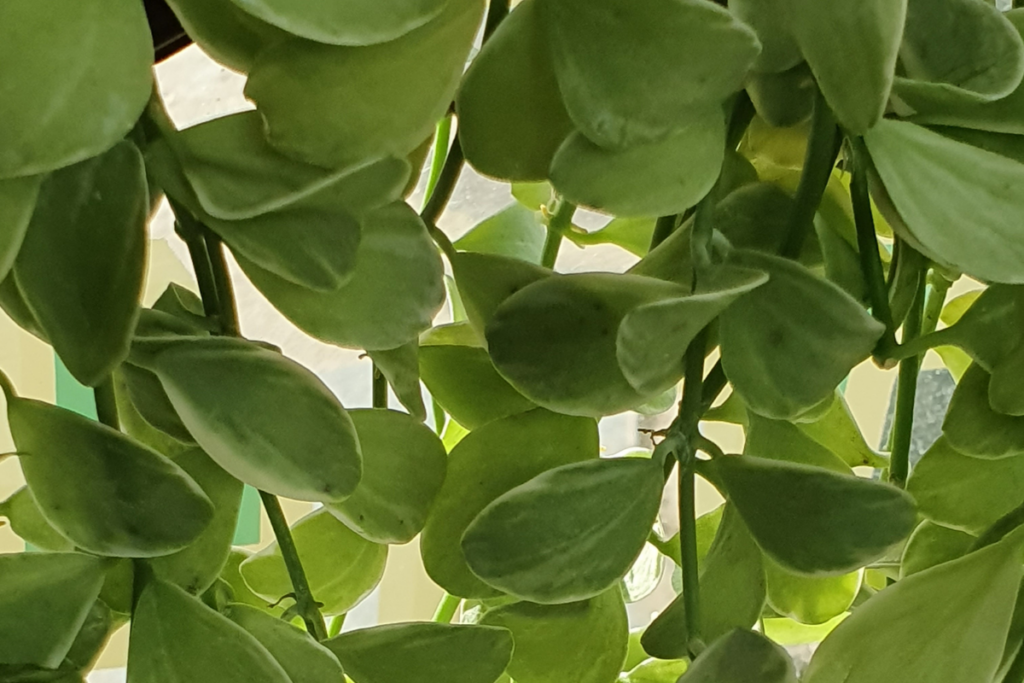
Propagation
The easiest way to propagate Hoya ‘Krimson Queen’ is through cuttings. The steps are more or less the same as any other Hoya Carnosa. First, choose a young cutting with up to three leaves and no flowers. You can grow your cuttings in soil or water or use a propagation medium like perlite or peat moss.
The best time for propagation is in spring or summer. You can also propagate in fall or in winter, but it will most likely take a little longer before you have a new plant.
Pruning
Pruning removes dead and dying branches, making room for new growth and protecting your plant from damage. Hoya Tricolor is a fast grower, but to shape and control its vigorous growth, prune it. Also, remove dead leaves and unhealthy-looking areas to keep it more robust.
Better cut off some dead branches, bad branches, too dense branches, and young branches from the Hoya Krimson Queen. This can also improve ventilation and prevent diseases and pests. Avoid excessive pruning so as not to hinder the flowering process.
Potting And Repotting
The Hoya Krimson Queen loves to be re-potted frequently. Depending on how much it has grown, you can re-pot it every year or two. The spring and summer months are ideal for re-potting Hoya. However, remember that when re-potting in winter or autumn, the plant may have the energy to fill the new pot with roots quickly.
Hoya Tricolor requires soil with good drainage that is very loose and has excellent potting soil. Do not water immediately after re-potting; let the plants settle into their new mix for 2-3 days before watering. A pot, such as a hanging pot, is recommended for the plant. However, you should choose a pot that will prevent the roots from becoming tangled.
Hoya Krimson Care Care
| Light | Bright indirect light |
| Temperature | Intermediate to warm, 61-95 degrees Fahrenheit |
| Water | Once a week, increased in summer, decreased in winter |
| Soil | Airy, well-draining soil, loose |
| Fertilization | Regular household fertilizer, once a month |
| Space | Plenty of space to creep or climb |
| Propagation | Via root division, plantlets, and seeds |
| Blooming | Spring and summer |
| Pruning | Regular pruning to improve growth |
| Potting | Regular potting mix, use of peat moss, perlite, gravel, vermiculite, humus, charcoal, orchid bark, coconut husk, and clay balls. |
RELATED: Alocasia Maharani: Helpful Plant Information and Care Guide For This Rare Beauty
Problems And Troubleshooting
Overwatering
If you notice wilted leaves on a Hoya, it can be a sign of being underwater or overwater. It is very easy to overwater a hoya plant because these kinds of plants are drought tolerant and should not be overwatered. A common problem with Hoya Krimson Queen is stem and root rot.
Some useful tips:
- Use a pot with at least one drainage hole.
- Use potting soil that drains well.
- Water only when the soil feels dry.
Underwatering
Hoyas prefer to stay mostly dry. However, they can also dry out if they are not watered enough. Therefore, another possible reason for your Hoya’s slow growth is a lack of water. Wrinkled leaves are sure that your plant is not getting enough water to maintain a normal growth rate.
Hoya ‘Krimson Queen’ should be watered whenever the topsoil is completely dry. Depending on your environment, this can be one to three times a week. However, Hoyas are more sensitive to over-watering, so it is preferable to under-water rather than over-water.
Nutrient Deficiency
The nutrient deficit is also indicated by stunted development and leaf deformation. Nitrogen shortage is the most prevalent of these.
Some useful suggestions:
- Indoor temperatures are good in general but avoid cold drafts and excessive heat.
- Keep Hoya Tricolor in filtered or indirect light.
- Use phosphorus-rich fertilizer instead of nitrogen- and potassium-rich fertilizer. Nitrogen (N), on the other hand, is mainly used to promote vegetative (leaf) growth.
- The best defense is to take great care of your indoor plant.
Flowering Problems
It took three years for the Hoya Krimson Queen to bloom. This is because the spurs do not create flower buds once they emerge, but they can carry flowers throughout the season once they are present. As a result, it’s essential to keep an eye on the spurs, which carry the flowers each season.
If buds break off before blooming, it’s possible that the potting medium was either too dry or too moist for too long.
Pests
Hoyas attract pests. The most frequent pests that affect your Hoya Krimson Queen are mealybugs, spider mites, and scale. Furthermore, when a plant is stressed, it is more vulnerable to fungi, bacteria, and insects.
Hoya Krimson Queen Pests And Diseases
| Common Pests/Diseases | Symptoms | Treatment and Prevention |
Common diseases include crown rot, stem rot, root rot, leaf spot, fungal diseases, and Xanthomonas infection | Yellowish rimming around black or dark brown spots on leaves | Avoid overwatering. Keep soil dry. Avoid too high humidity.Proper ventilation is needed around the plant. Remove infected parts of fungal infections to avoid spreading |
| Common pests include mealybugs, spider mites, aphids, and scales | Visible insects on the surface | Spray plant with warm, soapy water. If infestation is present, use insecticide or neem oil. Use diatomaceous earth. |
Problems with People and Animals
Toxicity
The Hoya Krimson Queen, like other plants of its genus, is hazardous. Children or dogs should not eat hoya plants since they generate a hazardous milky white sap. The sap is toxic to animals or humans, and it can make them unwell when ingested.
Hoya Plants Meaning And Symbolism
The Hoya Tricolor Flower produces lovely circular clusters of fragrant flowers. The wax plant represents wealth and safety. It is best given to people who you wish for safety at all times and prosperity in life.
| General Meaning | Wealth and safety |
| Symbolism | Prosperity and safety |
Landscaping And Gardening Ideas
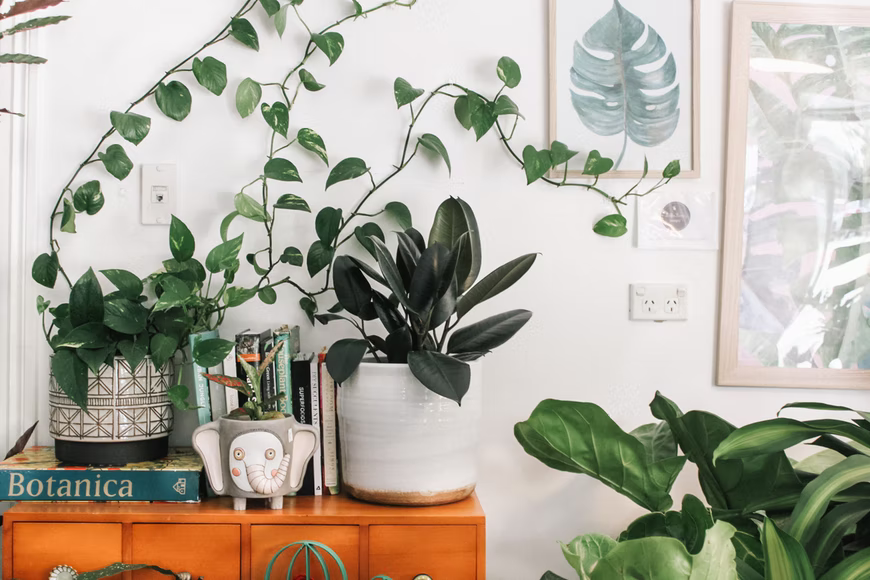
Companion Plants
These plants are famous for their waxy leaves and beautiful, fragrant star-shaped flowers. Hoya is a good plant for solo growing but can also be grown near other species.
Other tropical vines, such as neon pothos, can complement your hoyas. The neon color of this particular pothos will indeed become an eye-catcher. Prayer plants are also good companion plants alongside hoyas and neon pothos. The foliage of these plants goes well together. Put them in a rustic planter for a more premium and artistic feel.
Landscaping Ideas
The perfect place for your Hoya Krimson Queen is an east-going window with plenty of bright, indirect light. Most Hoya plants do well in particularly small pots and are especially well-suited to basket cultivation. They may be located everywhere to provide a natural look to your home.
If you put your Hoya outdoors, make sure it receives ample shade from direct sunlight. To create an accent in your spaces, you can grow your hoya plants on a trellis or in a basket, along with other vines. This will surely make your space vibrant and premium-looking.
| What to plant with | Tropical vines such as neon pothos and prayer plants, other tropical plants |
| What NOT to plant with | Basically nothing |
Conclusion
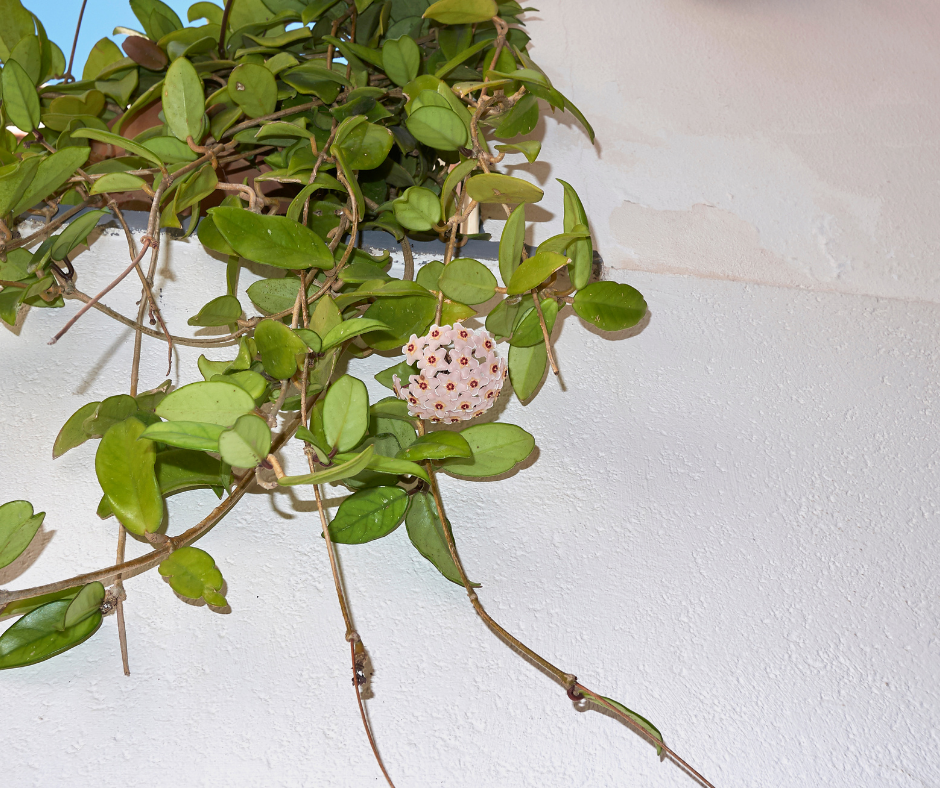
Overall, the Hoya Krimson Queen makes an ideal low-maintenance houseplant for pretty much any houseplant. It is a variegated wax plant local to Southeast Asia. The Krimson Queen, a variegated variant of Hoya carnosa, is also called Hoya Tricolor and Hoya Variegata.
Its leaves are either pink or white, turning creamy white around the leaf edges, and it develops thick groups of chocolate-scented blossoms. The Hoya Krimson Queen plant is beautiful and fast-growing under the proper care.
FAQS
Does The Hoya Krimson Queen Grow Fast?
The variegated variant of Hoya carnosa, Hoya Krimson Queen, is a fast-growing vine assuming proper care and attention. Ensure that your plant receives adequate lighting, fertilizer, humidity, and watering frequency.
Does The Hoya Krimson Queen Bloom?
Yes! Hoya Krimson Queen is a flowering vine, being an angiosperm. It flowers in the summer and spring seasons, when temperatures rise and humidity levels in the environment increase. Proper light quality and amount are also critical for flowering since the flowering genes of the plant are light-activated.
Why Is My Hoya Krimson Queen Browning?
The browning of the plants can be due to several reasons. However, most of these symptoms are caused by water stress, particularly overwatering. Rectify your watering schedule if this is the leading cause.
However, too much light can also make your foliage brown. Make sure to place them in a bright indirect light setting to avoid having this problem.
What Is The Difference Between Krimson Queen And Princess?
The Hoya Krimson Queen and Hoya Krimson Princess are both variegated variants of Hoya carnosa. They can be easily confused with one another because of the close similarities of their foliage. However, upon closer inspection, the leaves’ color of the leaf margins is not the same.
The Hoya Krimson Queen has green leaves with cream and pink margins, while the Hoya Krimson Queen is the opposite; cream leaves with green margins.
How Do You Care For A Hoya Krimson Queen?
The care for Hoya Krimson Queen is not easy. A bright indirect light, high humidity, well-draining potting soil, and a proper watering schedule are a must to have a thriving plant. You may also need to feed your plant once a month to facilitate its growth and development.
Do you want to share your tips on how to take care of Hoya Krimson Queen? Comment down below. Also, check out our other articles:
Alocasia Mickey Mouse: A Useful and Complete Care, Propagation, and Watering Guide
Philodendron Birkin: Its Most Informative Care, Propagation, and Watering Guide
Monstera adansonii: The Complete Care, Propagation, and Watering Guide You Need







